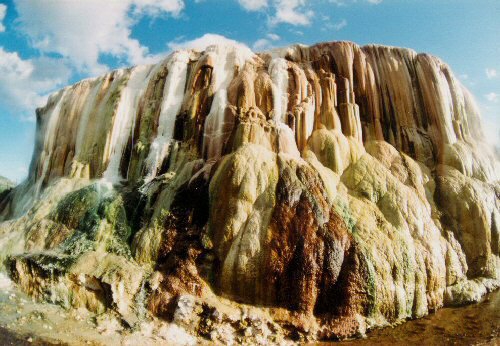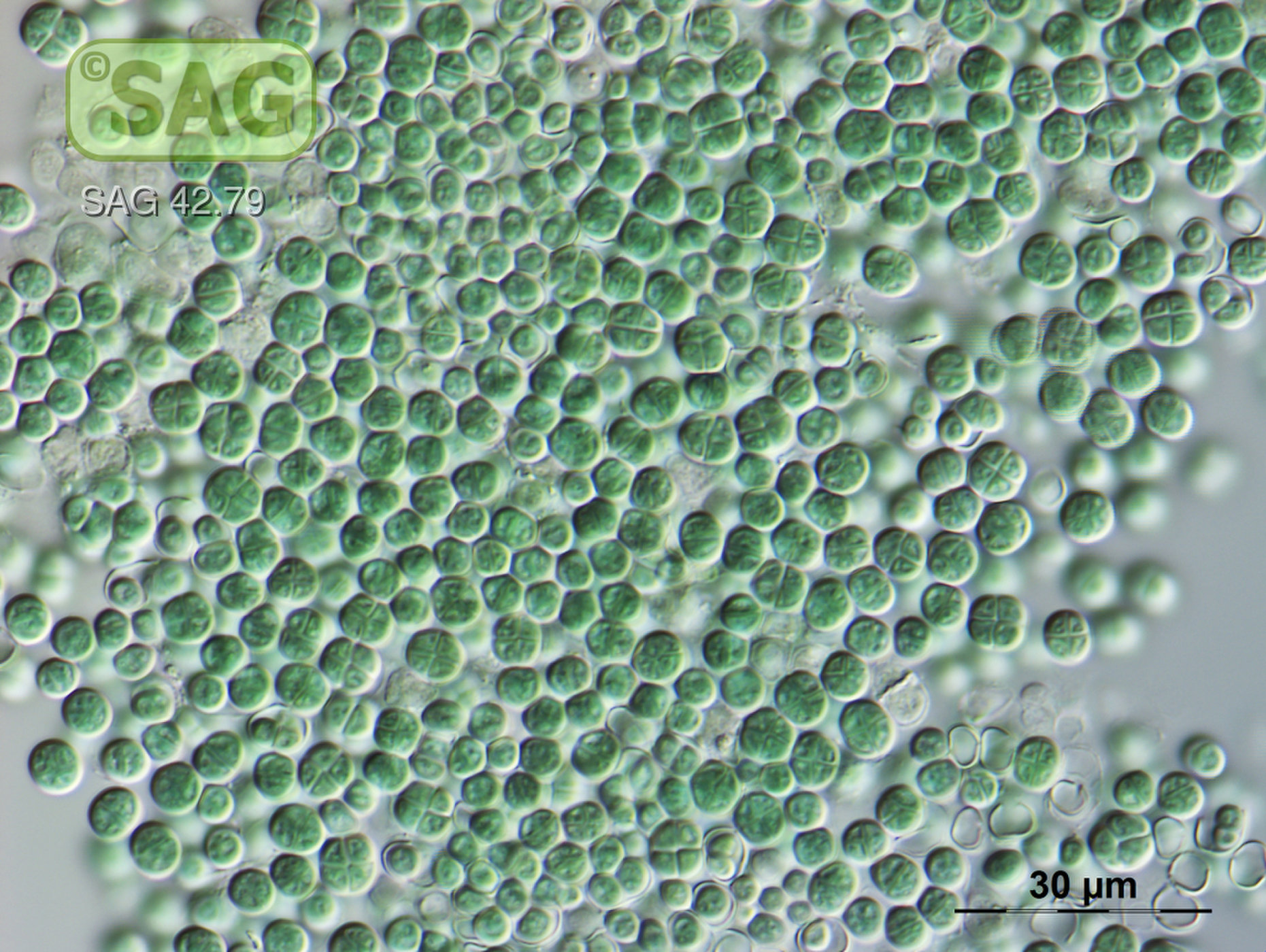|
Winfrenatia Reticulata
''Winfrenatia'' is a genus that contains the oldest-known terrestrial lichen, occurring in fossils preserved in the lower Devonian Rhynie chert. The genus contains the single species ''Winfrenatia reticulata'', named for the texture of its surface. Both the species and the genus were described in 1997. It comprises a thallus, made of layered, aseptate hyphae, with a number of depressions on its top surface. Each depression contains a net of hyphae holding a sheathed cyanobacterium. The fungus appears to be related to the Zygomycetes, and the photosynthetic partner of photobiont resembles the coccoid cyanobacteria '' Gloeocapsa'' and '' Chroococcidiopsis''. Three-component symbiosis Re-examination of thin sections from the Rhynie chert shows that ''Winfrenatia'' is more intricate than the standard two-partner lichen model. The bulk of its ridged thallus is made up of empty, mucilage-lined sheaths that once housed a filamentous cyanobacterium resembling modern Nostocales; these s ... [...More Info...] [...Related Items...] OR: [Wikipedia] [Google] [Baidu] |
Genus
Genus (; : genera ) is a taxonomic rank above species and below family (taxonomy), family as used in the biological classification of extant taxon, living and fossil organisms as well as Virus classification#ICTV classification, viruses. In binomial nomenclature, the genus name forms the first part of the binomial species name for each species within the genus. :E.g. ''Panthera leo'' (lion) and ''Panthera onca'' (jaguar) are two species within the genus ''Panthera''. ''Panthera'' is a genus within the family Felidae. The composition of a genus is determined by taxonomy (biology), taxonomists. The standards for genus classification are not strictly codified, so different authorities often produce different classifications for genera. There are some general practices used, however, including the idea that a newly defined genus should fulfill these three criteria to be descriptively useful: # monophyly – all descendants of an ancestral taxon are grouped together (i.e. Phylogeneti ... [...More Info...] [...Related Items...] OR: [Wikipedia] [Google] [Baidu] |
Gloeocapsa
''Gloeocapsa'' (from the Greek ''gloia'' (gelatinous) and the Latin ''capsa'' (case)) is a genus of cyanobacteria. The cells secrete individual gelatinous sheaths which can often be seen as sheaths around recently divided cells within outer sheaths. Recently divided cell pairs often appear to be only one cell since the new cells cohere temporarily. They are also known as glow caps, a term derived from the yellowish hue given off by the cap. Occurrence Some species of this genus are halophiles and hence found in hypersaline lakes and other high salinity environments. An example of such occurrence of the genus is in the Makgadikgadi Pans of Botswana Botswana, officially the Republic of Botswana, is a landlocked country in Southern Africa. Botswana is topographically flat, with approximately 70 percent of its territory part of the Kalahari Desert. It is bordered by South Africa to the sou .... '' Gloeocapsa magma'' is noted for colonising roof shingles in the United States and ... [...More Info...] [...Related Items...] OR: [Wikipedia] [Google] [Baidu] |
Fungi
A fungus (: fungi , , , or ; or funguses) is any member of the group of eukaryotic organisms that includes microorganisms such as yeasts and mold (fungus), molds, as well as the more familiar mushrooms. These organisms are classified as one of the kingdom (biology)#Six kingdoms (1998), traditional eukaryotic kingdoms, along with Animalia, Plantae, and either Protista or Protozoa and Chromista. A characteristic that places fungi in a different kingdom from plants, bacteria, and some protists is chitin in their cell walls. Fungi, like animals, are heterotrophs; they acquire their food by absorbing dissolved molecules, typically by secreting digestive enzymes into their environment. Fungi do not photosynthesize. Growth is their means of motility, mobility, except for spores (a few of which are flagellated), which may travel through the air or water. Fungi are the principal decomposers in ecological systems. These and other differences place fungi in a single group of related o ... [...More Info...] [...Related Items...] OR: [Wikipedia] [Google] [Baidu] |
Fossil Taxa Described In 1997
A fossil (from Classical Latin , ) is any preserved remains, impression, or trace of any once-living thing from a past geological age. Examples include bones, shells, exoskeletons, stone imprints of animals or microbes, objects preserved in amber, hair, petrified wood and DNA remnants. The totality of fossils is known as the ''fossil record''. Though the fossil record is incomplete, numerous studies have demonstrated that there is enough information available to give a good understanding of the pattern of diversification of life on Earth. In addition, the record can predict and fill gaps such as the discovery of ''Tiktaalik'' in the arctic of Canada. Paleontology includes the study of fossils: their age, method of formation, and evolutionary significance. Specimens are sometimes considered to be fossils if they are over 10,000 years old. The oldest fossils are around 3.48 billion years to 4.1 billion years old. Early edition, published online before print. The ob ... [...More Info...] [...Related Items...] OR: [Wikipedia] [Google] [Baidu] |
Hot Spring
A hot spring, hydrothermal spring, or geothermal spring is a Spring (hydrology), spring produced by the emergence of Geothermal activity, geothermally heated groundwater onto the surface of the Earth. The groundwater is heated either by shallow bodies of magma (molten rock) or by circulation through fault (geology), faults to hot rock deep in the Earth's crust. Hot spring water often contains large amounts of dissolved minerals. The chemistry of hot springs ranges from acid sulfate springs with a pH as low as 0.8, to alkaline chloride springs saturated with silica, to bicarbonate springs saturated with carbon dioxide and carbonate minerals. Some springs also contain abundant dissolved iron. The minerals brought to the surface in hot springs often feed communities of extremophiles, microorganisms adapted to extreme conditions, and it is possible that life on Earth had its origin in hot springs. Humans have made use of hot springs for bathing, relaxation, or medical therapy for th ... [...More Info...] [...Related Items...] OR: [Wikipedia] [Google] [Baidu] |
Pioneer Species
Pioneer species are resilient species that are the first to colonize barren environments, or to repopulate disrupted biodiverse steady-state ecosystems as part of ecological succession. Various kinds of events can create good conditions for pioneers, including disruption by natural disasters, such as wildfire, flood, mudslide, lava flow or a climate-related extinction event, or by anthropogenic habitat destruction, such as through land clearance for agriculture or construction or industrial damage. Pioneer species play an important role in creating soil in primary succession, and stabilizing soil and nutrients in secondary succession. For humans, because pioneer species quickly occupy disrupted spaces, they are sometimes treated as weeds or nuisance wildlife, such as the common dandelion or stinging nettle. Even though humans have mixed relationships with these plants, these species tend to help improve the ecosystem because they can break up compacted soils and accumulate ... [...More Info...] [...Related Items...] OR: [Wikipedia] [Google] [Baidu] |
Nitrogen Fixation
Nitrogen fixation is a chemical process by which molecular dinitrogen () is converted into ammonia (). It occurs both biologically and abiological nitrogen fixation, abiologically in chemical industry, chemical industries. Biological nitrogen fixation or ''diazotrophy'' is catalyzed by enzymes called nitrogenases. These enzyme complexes are encoded by the Nif gene, ''Nif'' genes (or ''Nif'' homologs) and contain iron, often with a second metal (usually molybdenum, but sometimes vanadium). Some nitrogen-fixing bacteria have symbiotic relationships with plants, especially legumes, mosses and aquatic ferns such as ''Azolla''. Looser non-symbiotic relationships between diazotrophs and plants are often referred to as associative, as seen in nitrogen fixation on rice roots. Nitrogen fixation occurs between some termites and fungus, fungi. It occurs naturally in the air by means of NOx, NOx production by lightning. Fixed nitrogen is essential to life on Earth. Organic compounds such ... [...More Info...] [...Related Items...] OR: [Wikipedia] [Google] [Baidu] |
Photosynthesis
Photosynthesis ( ) is a system of biological processes by which photosynthetic organisms, such as most plants, algae, and cyanobacteria, convert light energy, typically from sunlight, into the chemical energy necessary to fuel their metabolism. ''Photosynthesis'' usually refers to oxygenic photosynthesis, a process that produces oxygen. Photosynthetic organisms store the chemical energy so produced within intracellular organic compounds (compounds containing carbon) like sugars, glycogen, cellulose and starches. To use this stored chemical energy, an organism's cells metabolize the organic compounds through cellular respiration. Photosynthesis plays a critical role in producing and maintaining the oxygen content of the Earth's atmosphere, and it supplies most of the biological energy necessary for complex life on Earth. Some bacteria also perform anoxygenic photosynthesis, which uses bacteriochlorophyll to split hydrogen sulfide as a reductant instead of water, p ... [...More Info...] [...Related Items...] OR: [Wikipedia] [Google] [Baidu] |
Nostocales
The Nostocales are an order of cyanobacteria Cyanobacteria ( ) are a group of autotrophic gram-negative bacteria that can obtain biological energy via oxygenic photosynthesis. The name "cyanobacteria" () refers to their bluish green (cyan) color, which forms the basis of cyanobacteri ... containing most of its species. It includes filamentous forms, both simple or branched, and both those occurring as single strands or multiple strands within a sheath. Some members show a decrease in width from the base, and some have heterocysts. References Bacteria orders {{cyanobacteria-stub ... [...More Info...] [...Related Items...] OR: [Wikipedia] [Google] [Baidu] |
Mucilage
Mucilage is a thick gluey substance produced by nearly all plants and some microorganisms. These microorganisms include protists which use it for their locomotion, with the direction of their movement always opposite to that of the secretion of mucilage. It is a polar glycoprotein and an exopolysaccharide. Mucilage in plants plays a role in the storage of water and food, seed germination, and thickening membranes. Cacti (and other succulents) and flax seeds are especially rich sources of mucilage. Occurrence Exopolysaccharides are the most stabilising factor for microaggregates and are widely distributed in soils. Therefore, exopolysaccharide-producing "soil algae" play a vital role in the ecology of the world's soils. The substance covers the outside of, for example, unicellular or filamentous green algae and cyanobacteria. Amongst the green algae especially, the group Volvocales are known to produce exopolysaccharides at a certain point in their life cycle. It occu ... [...More Info...] [...Related Items...] OR: [Wikipedia] [Google] [Baidu] |
Chroococcidiopsis
''Chroococcidiopsis'' is a photosynthetic, coccoidal bacterium, and the only genus in the order Chroococcidiopsidales and in the family Chroococcidiopsidaceae. A diversity of species and cultures exist within the genus, with a diversity of phenotypes. Some extremophile members of ''Chroococcidiopsis'' are known for their ability to survive harsh environmental conditions, including both high and low temperatures, ionizing radiation, and high salinity. ''Chroococcidiopsis'' are able to survive in a dormant state for at least 13 million years, with the ability to reactivate after this time. Desiccation resistance The ability of ''Chroococcidiopsis'' to resist desiccation in arid environments is due in part because it colonizes the underside of translucent rocks. The underside of these rocks provides enough condensed moisture for growth while the rock's translucent nature allows just enough light to reach the organism for photosynthesis to occur. A 2023 study found ''Chroococcidiop ... [...More Info...] [...Related Items...] OR: [Wikipedia] [Google] [Baidu] |
Coccus
Bacterial cellular morphologies are the shapes that are characteristic of various types of bacteria and often key to their identification. Their direct examination under a light microscope enables the classification of these bacteria (and archaea). Generally, the basic morphologies are spheres (coccus) and round-ended cylinders or rod shaped (bacillus). But, there are also other morphologies such as helically twisted cylinders (example '' Spirochetes''), cylinders curved in one plane (selenomonads) and unusual morphologies (the square, flat box-shaped cells of the Archaean genus '' Haloquadratum)''. Other arrangements include pairs, tetrads, clusters, chains and palisades. Types Coccus A coccus (plural ''cocci'', from the Latin ''coccinus'' (scarlet) and derived from the Greek ''kokkos'' (berry)), is any microorganism (usually bacteria) whose overall shape is spherical or nearly spherical. Coccus refers to the shape of the bacteria and can contain multiple genera, such as st ... [...More Info...] [...Related Items...] OR: [Wikipedia] [Google] [Baidu] |






